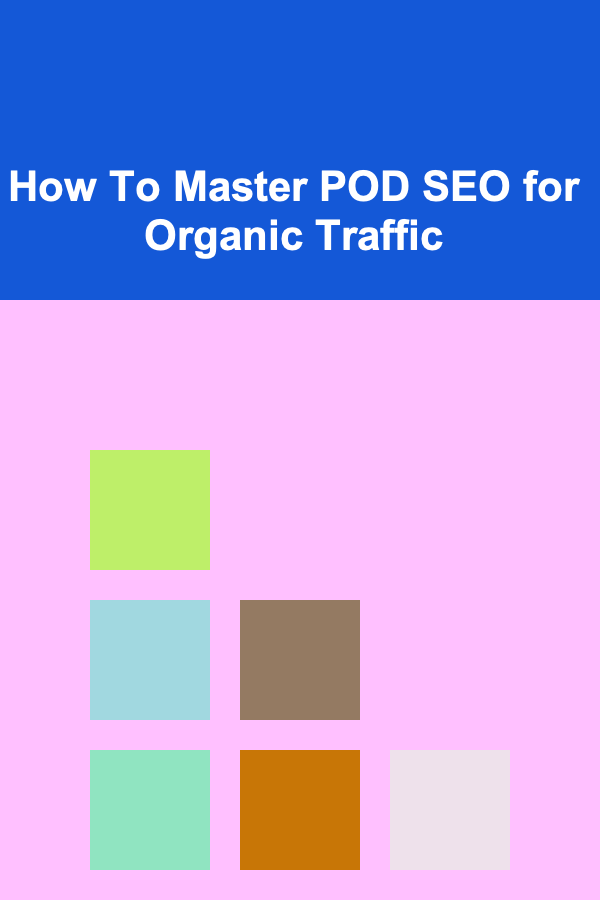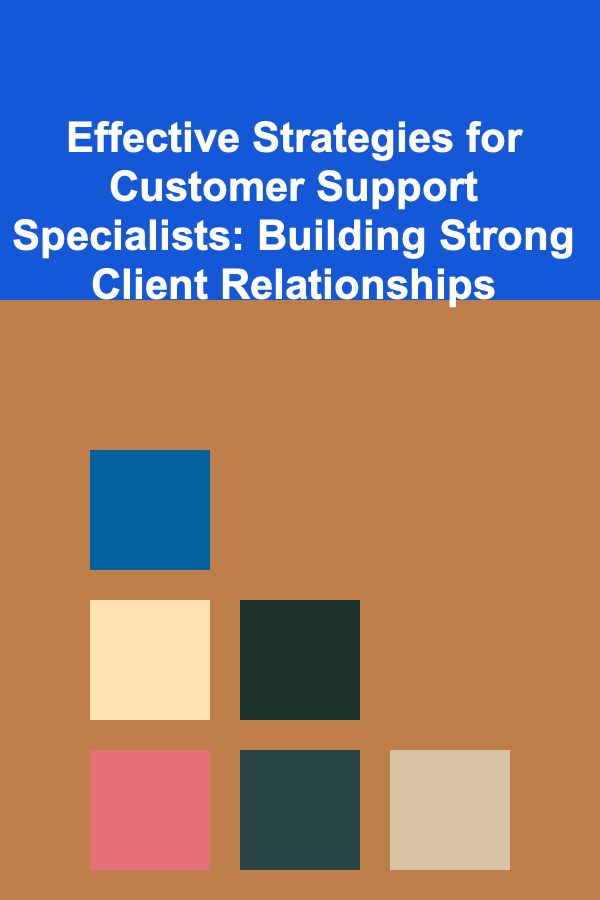
How To Master POD SEO for Organic Traffic
ebook include PDF & Audio bundle (Micro Guide)
$12.99$7.99
Limited Time Offer! Order within the next:

Print on Demand (POD) businesses are booming in the eCommerce world, allowing entrepreneurs to create and sell custom designs on a wide range of products without needing to manage inventory. The convenience and scalability of POD have attracted many, but with increasing competition, it's crucial to stand out and drive organic traffic to your store. One of the most effective ways to do this is through POD SEO (Search Engine Optimization). SEO allows you to optimize your website and product listings to rank higher on search engines, bringing in organic traffic without spending money on ads.
This article will delve into the critical components of mastering POD SEO and offer actionable strategies to help you boost your visibility, rank higher in search results, and ultimately generate more sales.
Understanding POD SEO
SEO is the process of optimizing your website, product listings, and content so that search engines like Google, Bing, or even Etsy can rank you higher in their search results. POD SEO focuses on applying these principles specifically to Print on Demand stores, with a few added layers such as product descriptions, design keywords, and platform-specific SEO techniques. The goal is to get your POD store to appear in the search engine results page (SERP) when potential customers are looking for products you sell.
In essence, the more relevant your content is to the searcher's query, the higher your chances of appearing at the top of the SERPs. Mastering POD SEO means understanding how to target the right keywords, create optimized listings, and engage in sustainable long-term SEO strategies.
Step 1: Research Your Niche and Keywords
Effective SEO starts with keyword research. In the context of POD, keyword research allows you to identify the terms and phrases potential customers are typing into search engines when looking for the types of products you offer. By targeting the right keywords, you ensure that your POD store and products are visible to the right audience.
Finding the Right Keywords
There are several tools you can use to identify high-traffic keywords that align with your niche. Some popular options include:
- Google Keyword Planner: This tool can help you discover search volumes for keywords related to your products and even offer suggestions based on your ideas.
- Ubersuggest: A free tool that provides keyword suggestions, search volume, and SEO difficulty.
- Ahrefs or SEMrush: Paid tools that offer advanced keyword research capabilities, including keyword difficulty, competition analysis, and search intent.
Consider Search Intent
When researching keywords, consider search intent---the purpose behind a search. Is the user looking for product ideas? Do they want a specific design or type of product? Are they looking for reviews or recommendations?
Search intent is typically classified into four categories:
- Navigational: Searching for a specific website or page.
- Informational: Looking for information on a topic.
- Transactional: Ready to purchase a product.
- Commercial Investigation: Comparing products or researching potential purchases.
For a POD business, your focus should primarily be on transactional and commercial investigation intent, as these are most likely to result in conversions.
Long-Tail Keywords
Long-tail keywords are phrases that are more specific and typically have lower search volumes, but they often have a higher conversion rate. For example, instead of just targeting "T-shirt," you might target a more specific phrase like "funny cat t-shirts for women." Although the search volume is lower, the competition is also lower, and the audience is more targeted.
Step 2: Optimize Your Product Listings
Once you have your keywords, it's time to optimize your product listings. Whether you're selling on your own website or on platforms like Etsy, Amazon, or Redbubble, there are several key areas to focus on.
Title Optimization
The title is one of the most important factors for SEO. It should be clear, concise, and include the primary keyword you're targeting. Avoid keyword stuffing, as this can make the title unnatural and difficult to read. Instead, aim for a balance of clarity and keyword inclusion.
Example:
- Poor Title: "T-shirt funny, best cat shirt, cute shirt for girls"
- Optimized Title: "Funny Cat T-Shirt for Women | Cute & Comfortable Design"
Product Descriptions
Your product descriptions are another crucial area for SEO. A well-written, informative product description will not only help search engines understand your product but will also give potential customers the information they need to make a purchase decision.
When writing product descriptions:
- Include relevant keywords, but avoid keyword stuffing.
- Make the description informative and persuasive. Highlight the unique selling points of your design.
- Keep the tone aligned with your brand's personality.
- Include variations, such as size or color options, if applicable.
High-Quality Images and Alt Text
Search engines can't read images, but they can read the alt text you provide for each image. Alt text helps search engines understand the content of your images and improves accessibility for visually impaired users.
Always include descriptive alt text that incorporates relevant keywords for each product image. For example, instead of using "image1.jpg," use "funny-cat-shirt-women.jpg" for a clearer and more SEO-friendly description.
Product Tags and Categories
When you upload a product to your store, make sure to fill out the tags and categories. This not only helps organize your store but also allows search engines to understand the different types of products you're offering.
For example, on Etsy, you can add tags like "funny cat shirt," "women's t-shirt," and "gift for cat lovers." On Shopify or WooCommerce, make sure to use product categories such as "Men's Apparel," "Women's Apparel," or "Pet Lover Gifts" to make your products easier to find.
Step 3: Focus on On-Page SEO
On-page SEO refers to the tactics you use on your website or product pages to improve rankings and drive organic traffic. These tactics include things like URL structure, meta descriptions, and internal linking.
URL Structure
Your product URLs should be clean, descriptive, and include relevant keywords. For example:
- Bad URL: www.example.com/product12345
- Good URL: www.example.com/funny-cat-t-shirt-women
Meta Descriptions
Meta descriptions are brief summaries of your product or page that appear below the title in search results. They don't directly impact rankings but can influence the click-through rate (CTR) to your site. A compelling meta description encourages users to click your link.
Example:
- "Get this cute and funny cat t-shirt for women, perfect for cat lovers! Comfortable and stylish, available in multiple sizes."
Internal Linking
Internal links help distribute link equity throughout your site and improve navigation. Make sure to link related products within your store. For instance, if you sell multiple cat-themed shirts, link them together in the product descriptions to increase time spent on your site and improve your rankings.
Step 4: Build Backlinks
Backlinks---links from other websites to your store---are one of the most influential ranking factors for SEO. Backlinks signal to search engines that your website is authoritative and trustworthy. The more quality backlinks you have, the higher you're likely to rank.
How to Get Backlinks
- Guest Posting: Write articles or blog posts for other websites in your niche. Include a link back to your store in your author bio or within the content.
- Influencer Marketing: Partner with influencers who can promote your products on their platforms, linking back to your store.
- Content Marketing: Create valuable content (like blog posts, videos, or infographics) that others in your niche may find useful and want to link to.
Step 5: Improve User Experience (UX)
Search engines prioritize websites that offer a great user experience. Websites with high bounce rates, slow loading times, and poor navigation are less likely to rank well.
Mobile Optimization
With the rise of mobile shopping, it's essential that your website is mobile-friendly. Ensure that your site is responsive and loads quickly on mobile devices. You can use Google's Mobile-Friendly Test to check your website's performance.
Page Speed
A fast website improves user experience and helps with SEO. Use tools like Google PageSpeed Insights or GTMetrix to identify and fix performance issues that might be slowing your website down.
Easy Navigation
A clean, easy-to-navigate website keeps visitors engaged and encourages them to explore more products. Include a clear product menu, intuitive filters, and an organized product catalog.
Step 6: Leverage Social Media and Content Marketing
Social media platforms can drive traffic to your POD store and improve SEO indirectly. By sharing your products, engaging with your audience, and building a community around your brand, you create valuable backlinks and improve brand recognition.
Pinterest is a powerful tool for POD sellers. Create pins showcasing your products, link back to your product pages, and ensure you're using optimized descriptions with relevant keywords. Many shoppers use Pinterest for gift ideas, making it a great platform for POD sales.
Blogging
Starting a blog related to your niche can boost your SEO. For instance, if you sell custom dog shirts, you could create blog posts about dog-related topics, product reviews, or pet owner tips. Blogs can target long-tail keywords, helping you rank for niche terms that your product pages may not cover.
Building a Social Media Following
Engage with your followers on social media platforms like Instagram, Facebook, and TikTok. Build a loyal community of fans who will share your posts, creating valuable backlinks and increasing visibility for your POD products.
Step 7: Track, Analyze, and Adjust
SEO is a long-term game, and it requires continuous monitoring and optimization. Use tools like Google Analytics , Google Search Console , and SEMrush to track your performance. These tools help you analyze traffic sources, keyword rankings, bounce rates, and more. Based on the data, adjust your SEO strategy to improve results.
By implementing these strategies and continuously optimizing your store, you'll be well on your way to mastering POD SEO and driving organic traffic to your store. The process can be time-consuming, but the rewards of higher visibility, more traffic, and ultimately more sales are well worth the effort. Stay committed, keep learning, and watch your POD business grow.

Effective Strategies for Customer Support Specialists: Building Strong Client Relationships
Read More
The Cloud Systems Engineer's Guide: Building Scalable and Secure Cloud Solutions
Read More
How to Understand the Search for SETI
Read More
Understanding the Connection Between Diet and Mood
Read More
The Power of Vulnerability: Building Intimacy and Trust
Read More
Geocaching for Beginners: Essential Gear and Skills
Read MoreOther Products

Effective Strategies for Customer Support Specialists: Building Strong Client Relationships
Read More
The Cloud Systems Engineer's Guide: Building Scalable and Secure Cloud Solutions
Read More
How to Understand the Search for SETI
Read More
Understanding the Connection Between Diet and Mood
Read More
The Power of Vulnerability: Building Intimacy and Trust
Read More